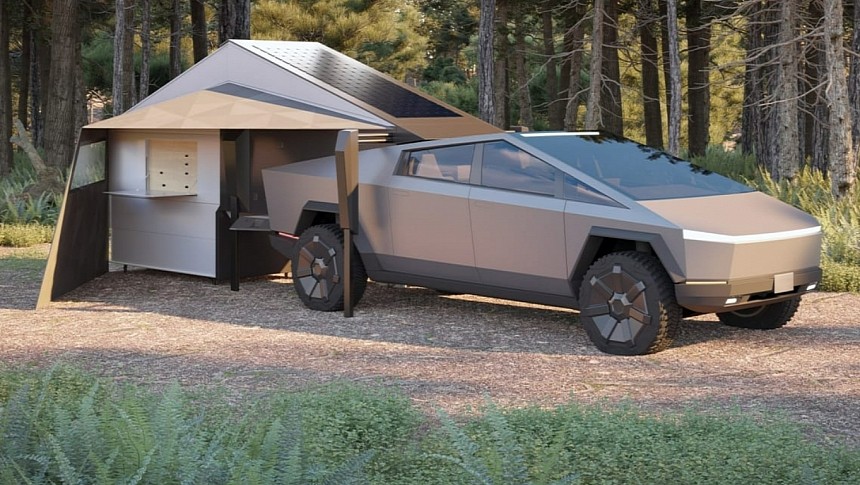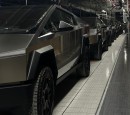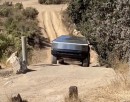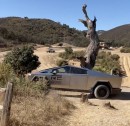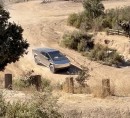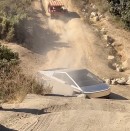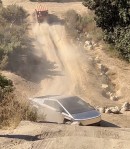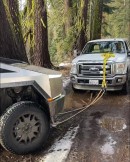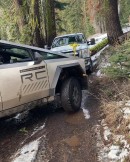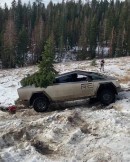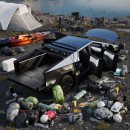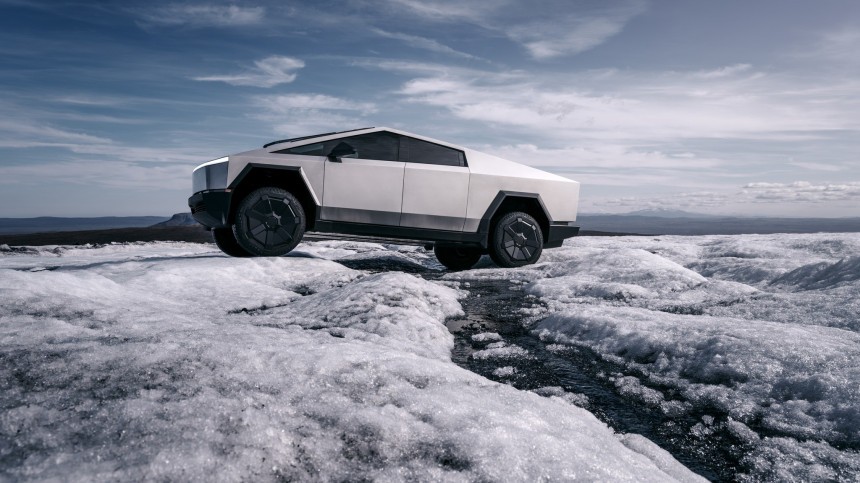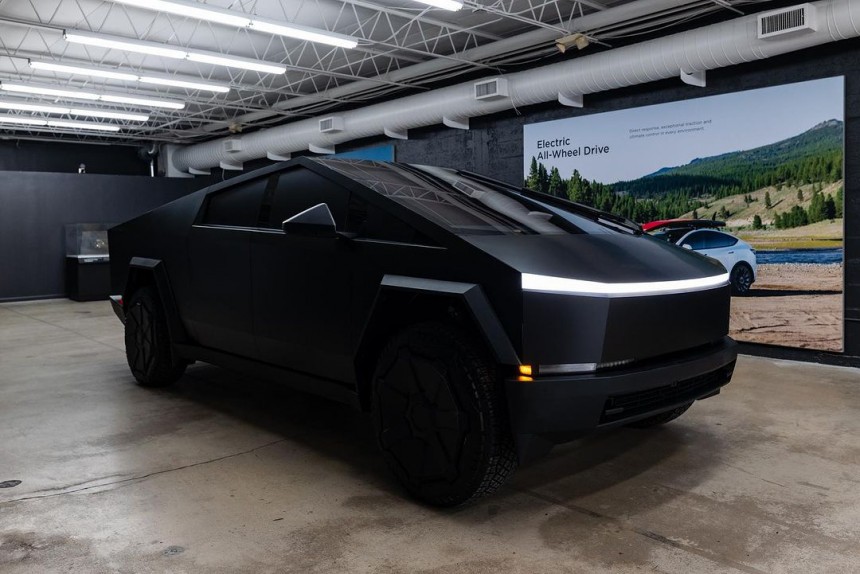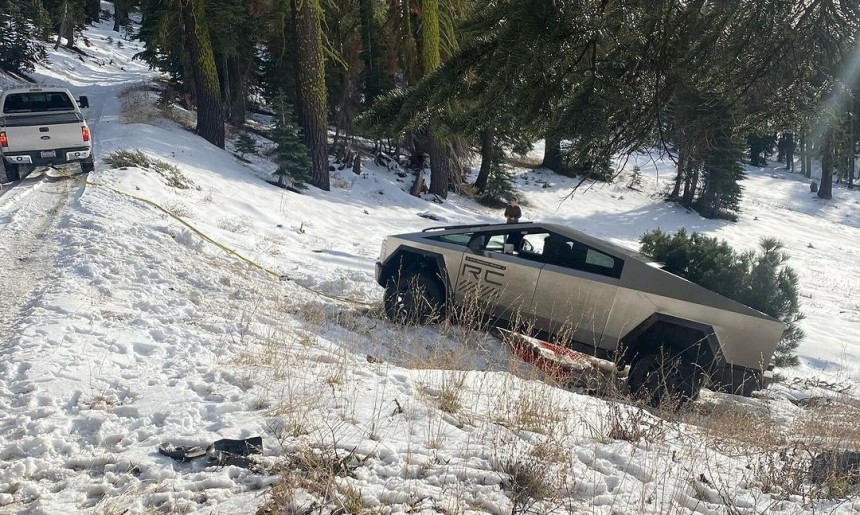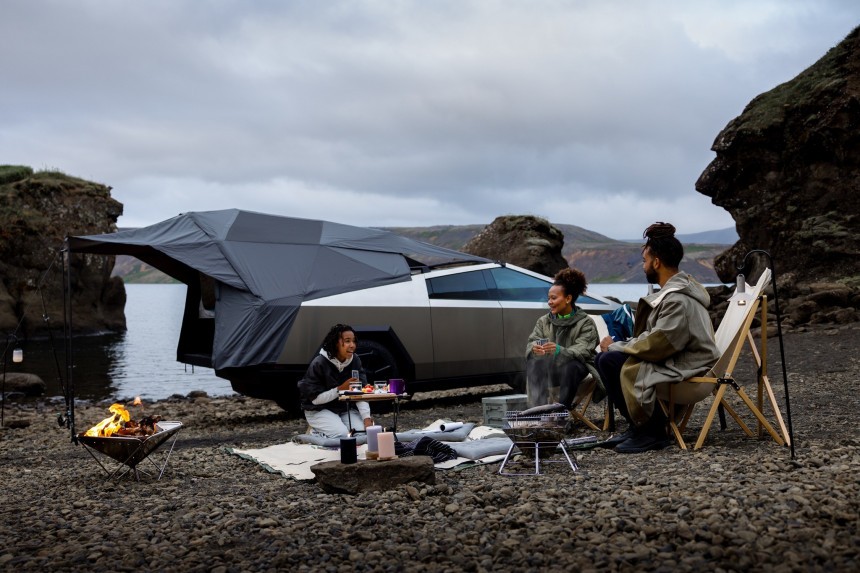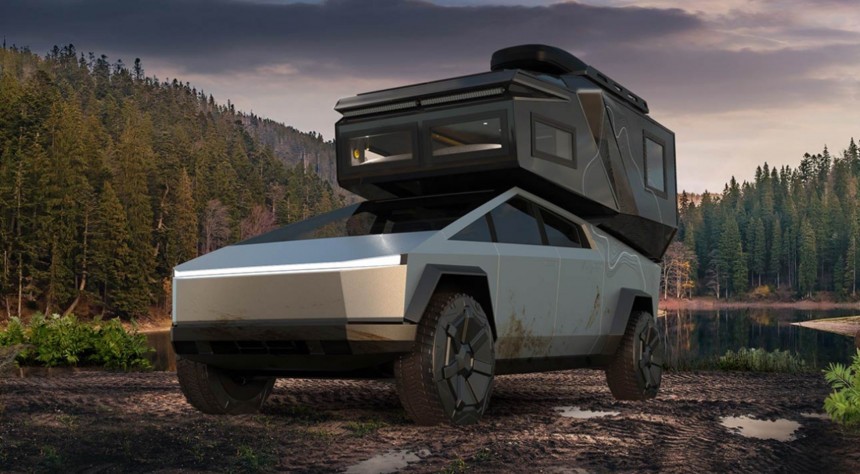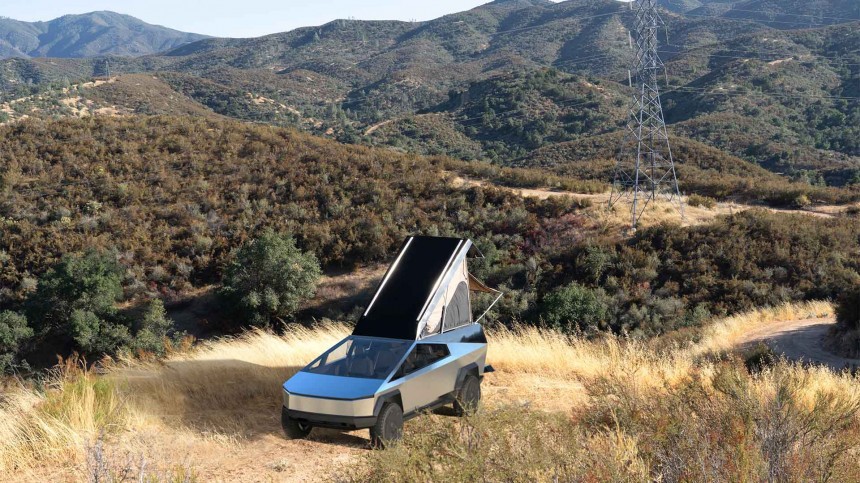Most of the discussions about the Tesla Cybertruck revolve around its distinctive design or its performance on the road. Today, I'd like to delve into a bit of a different topic: how well the Cybertruck fares when overlanding and camping.
It's been four years since Elon Musk first announced the Cybertruck concept, and finally, the wait is over. Some customers got their hands on the truck at the end of last month, but most will receive it sometime next year.
This electric beast is currently offered in two variants: a dual-motor version with 600 hp or the Cyberbeast with three motors delivering 845 hp. The Cybertruck is available to order only in the United States.
If you're from Europe and a Cybertruck fan, I'm sorry to disappoint you, but there's a high chance that this EV will never make it there. There are several reasons why – first, the Cybertruck is extremely heavy, weighing over 3.5 tons, which means European drivers need a category C1 license to drive it.
Second, the Cybertruck works with the Tesla NAC Standard, which is widely used across the US but is not compatible with the CCS network adopted by most European countries. And lastly, the truck segment is way less popular in Europe than it is in the US. Of course, Tesla could come up with a lighter and smaller European version for the Cybertruck, but it's currently not an attractive path for the company to go on, at least not for now.
Anyway, let's go on with the vehicle's specs. Since the Cyberbeast trim is more exciting and off-road suitable than the dual-motor version, it will be the topic of today's discussion. You'll have to empty out a hefty $99,980 (€91,493) for it, around $20K more than what we were originally promised in 2019. A rear-wheel drive version will also be released in 2025 for a more budget-friendly $60,990 (€55,813).
The tri-motor setup delivers 845 hp and 930 Nm (686 ft-lb.) of torque, which enable you to reach the 60-mph (97-kph) mark in a staggering 2.6 seconds, meaning the EV can go head-to-head with many vehicles, even supercars. For instance, its acceleration to 60 mph is just as fast as that of the Hennessey Venom F5. Moreover, the top speed is electronically limited to 130 mph (209 kph).
But since today we're talking about off-roading and camping, these speed-related specs are not as important as other details, such as payload and towing capacity. In this regard, the Cyberbeast tips the scales at 6,843 lb. (3,104 kg). Furthermore, it has an 11,000-lb. (4,990-kg) towing capacity and a 2,500-lb. (1,134-kg) payload. To flex its capabilities, Tesla released a video of the Cybertruck defeating a Porsche 911 in a drag race while towing another Porsche 911 – you can't deny it, if there's one auto manufacturer who knows how to hype up its products, it's Tesla.
Another critical factor is battery and range. In the Cyberbeast, energy is stored in a lithium-ion battery pack with a capacity of 123 kWh. It offers the EV an estimated EPA range of 320 miles (515 km) or 440 miles (708 km) with the range-extender setup.
The Cybertruck is the only electric truck that can be charged via a Tesla supercharger – it'll take a mere 15 minutes to charge the battery enough for a 128-mile (206 km) drive.
Just like I discussed in a recent article about overlanding, it's critical to have proper off-road features on your vehicle. The Cybertruck features an adjustable air suspension that allows for 17 inches (43.2 centimeters) of ground clearance. It rides on 20-inch wheels wrapped in 35-inch rubber, helping the EV achieve an approach angle of 35 degrees and a departure angle of 28 degrees.
But one of the biggest issues with the Cybertruck is its size – it's 223.7 inches (568.2 centimeters) long and 95 inches (241.3 centimeters) wide (including the mirrors), with a height of 70.5 inches (179 centimeters). To combat this, Tesla equipped the vehicle with a four-wheel steering system, allowing for a tighter turning radius.
Both vehicles sported the RC (which stands for Release Candidate) lettering on the left front side, meaning they were beta versions of the model. It was the first time we got how this electric truck fares against really rough surfaces and obstacles.
The drivers chose a cautious approach to these trails, driving slowly either to prevent damage or to test the off-road technologies in real-time. Moreover, it seemed to have the air suspension set to the highest setting. The Cybertruck seemed to have a difficult time at first, but slowly and steadily, it managed to go up the trail.
Of course, this video sparked controversy, with some people commenting about the EV's lack of off-road capabilities, while others quickly jumped into the conversation to defend the Cybertruck and place the blame on the driver and the choice of tires.
Lately, we've seen other instances of the Cybertruck off-roading, such as in the Tahoe National Forest. But one of the newest videos was published two days ago, and it didn't shine a pretty light for an off-roading Cybertruck.
The video was filmed at the Corral Hollow trail in California, and it depicted yet another RC version with a pine tree in the bed. However, this time, it somehow ended up far off the trail, stuck in the snow. It couldn't get out without assistance, likely not helped by its sheer weight. Moreover, reportedly, the truck's electro-mechanical locking differential wasn't working due to software issues.
This doesn't mean the Cybertruck is a bad off-road vehicle – you could argue that the truck was wearing improper tires or that the driver was out of his league skill-wise. Still, it doesn't look good to have a Ford tow Elon's much-praised electric truck.
To make things even worse, this release-candidate prototype didn't have the same recovery points as the road-going models – the Ford was able to save the Cybertruck by attaching the tow line to its suspension.
One of the craziest things Elon Musk initially announced regarding the Cybertruck is that it will be able to "float for a while." Given that he didn't mention anything during the Cybertruck Delivery Day event on November 30, we could've assumed the planned feature was scrapped.
However, the Cybertruck comes with an Off-Road Mode. It enables you to choose between two modes, Overland and Baja, adjust the handling balance, and three choices of Stability Assist: Standard, Reduce, or Min (for minimum). Another choice is Wade Mode, which "raises the ride height and pressurized battery when driving through water." Long story short, this mode will increase the inner pressure of the battery pack by using compressed air. This should enable the Cybertruck to survive a water crossing, but it clearly won't be able to float like initially said. We will surely see people trying this feature out, and that's when we'll be able to see how effective it truly is.
Of course, you could pack a diesel generator, but then it's better to stick to an ICE engine instead of going through all the hassle. But let's suppose you're not going overlanding but instead adventuring out in local areas.
We know the Cybertruck has the power to go off-road. But is it enough to pull the all-electric truck through sticky situations? Light off-roading definitely isn't a problem, but as you've seen in the earlier video, the van's weight might quickly render it useless when dealing with more demanding trails, even though its clearance is big enough to allow for some light rock climbing.
There's a myriad of cubby holes inside – for instance, you get a couple of cupholders, spacious door bins, two wireless charging pads in the center console, and a huge space underneath the armrest. What's more, there's just as much room in the back as in the front, meaning you have additional places to store your camping gear.
The Tesla Cybertruck is one of the best electric pickups when it comes to load carrying. The bed is protected by a super tough tonneau cover – and that's not just a claim. Even though it doesn't look like it, you can get on top of it and jump, and it can easily support the weight.
You get a massive 2,831 liters of space underneath the tonneau cover. By comparison, the RIvian R1T has just 827 liters, while the GMC Hummer EV boasts 1,039 liters. There's also a decently-sized frunk that can carry up to 441 lb. (200 kg).
It's not just spaced the bed offers, but also some useful features. You'll find some LED light bars, many tethering points, and, the best part, 230 V sockets for powering tools and appliances. However, if you're out and about in the wilderness, you'd probably want to preserve as much battery as possible. Moreover, there's a large locker under the floor with a drain plug, so you can fill it with ice, throw in some cold drinks, and enjoy.
Another thing I'd like to discuss is the EV's durability. Its stainless steel body will withstand all the typical shocks of off-roading, and, in the worst-case scenario, you'll just have a few dents. That's a big bonus that means you won't have to protect it as much as other off-road vehicles.
Even though most customers have yet to receive their Cybertruck, companies have already come up with several add-ons. But before we take a look at those, let's see what you can buy directly from Tesla.
For the interior, Tesla offers minimal upgrades: an under-seat storage bin, a glass roof sunshade, and a center console tray. For the exterior, you can opt for a paint film, either satin clear, black, or white. Moreover, you can add crossbars, a bumper protector, or a tailgate ramp.
The bed can also be customized with cargo dividers, molle panels, cargo bins, L-track hooks, cleats, D-rings, and even bottle openers. But the most expensive and impactful upgrade is the Basecamp tent. This $2,975 feature allows you to set up camp in the Cybertruck – it comes with an ultra-light airframe design that can be inflated in minutes.
The Basecamp features a nylon interior, screen windows, a soft mattress, and a weather-resistant outer shell with an extendable awning. This self-contained pack is mounted above the bed but below the tonneau cover, meaning you have some additional storage space.
When searching for off-road accessories for the Cybertruck, there's one name that will keep popping up: Unplugger Performance. This company offers several upgrades, all quite pricey. You can get an Invincible 2.5-inch lift kit in case the 17 inches of ground clearance are not enough. Unplugged Performance also provides a rear bumper complete with a trailer hitch receiver, a front camper, carbon fiber fender flares, rock sliders, underbody armor, wheels, and more.
If you decide to invest $30K or more for all these upgrades, you can turn the Cyberbeast into even more of an off-roading beast. Still, you need to sleep and live in when camping. And this is where the other camping packages come into action.
Several companies have already devised camping pods for the Cybertruck; I'll tell you about some of them. One option is the Loki Basecamp Cybertruck edition, a massive camper pod with a hefty price tag of $95,000 (€86,992). We don't know anything about its exact specs just yet.
Then, there's Cyberlandr, a camper pod complete with a kitchen, living room, bedroom, bathroom, and office, all integrated into a compact space. It features a monolithic roof equipped with solar panels, a compact design that can be extended via a fully automated mechanism.
Inside, you get plenty of storage space, a well-equipped kitchen with an induction cooktop, a folding sink, and a fridge. Moreover, it even has a toilet and a spa-inspired bathroom with a shower. The Cyberlandr is priced more modestly (compared to Loki's Basecamp) at $55,000 (€50,364).
Another camper pod comes from Form Camper. It features a carbon fiber shell and sits in the truck's bed, further extending outward toward the rear. When not deployed, just like the Cyberlandr, it doesn't affect the vehicle's aerodynamics. When deployed, it offers 195 square feet of indoor and outdoor dry space. Amazingly, it tips the scales at just 1,000 lb.
The Form Camper has an indoor and outdoor kitchen, 400 W solar panels, a detachable and free-standing design, a shower, a fridge, a stove, and 100 gallons (179 liters) of fresh water. The Form Camper is available for $64,500 (€59,063) if you pay a $500 down payment, although you can lower the price up to $49,500 (€45,327) if you pay a $10,000 (€9,157) down payment.
Space Campers also offers two options for the Cybertruck: The Cap and The Wedge. The Cap is a lightweight truck topper designed to increase the Cybertruck's cargo space while also providing additional security and weather protection. We don't know much about it, as it will be released around 2025.
The Wedge is a 470-lb. tent extension that mounts directly to your truck's bed. It features a simple construction with an adjustable awning, an exhaust vent, storage spots, electrical outlets, and more. The Wedge boasts a $24,000 (€21,977) presale price, with production scheduled to begin next year.
The Cybertruck was not made for off-roading, and it's up to par with other EV pickups. Is it able to go off-road? Yes. Can you go overlanding or camping in it? Well, it's doable, but it will hardly be enjoyable.
If you're interested in overlanding, check out my article on the ten best overlanding vehicles of 2023. You won't find any EVs on that list, and for a good reason. Maybe, at some point, we'll have the technology and features to make an EV a good camper, but we're not there yet.
This electric beast is currently offered in two variants: a dual-motor version with 600 hp or the Cyberbeast with three motors delivering 845 hp. The Cybertruck is available to order only in the United States.
If you're from Europe and a Cybertruck fan, I'm sorry to disappoint you, but there's a high chance that this EV will never make it there. There are several reasons why – first, the Cybertruck is extremely heavy, weighing over 3.5 tons, which means European drivers need a category C1 license to drive it.
Second, the Cybertruck works with the Tesla NAC Standard, which is widely used across the US but is not compatible with the CCS network adopted by most European countries. And lastly, the truck segment is way less popular in Europe than it is in the US. Of course, Tesla could come up with a lighter and smaller European version for the Cybertruck, but it's currently not an attractive path for the company to go on, at least not for now.
The tri-motor setup delivers 845 hp and 930 Nm (686 ft-lb.) of torque, which enable you to reach the 60-mph (97-kph) mark in a staggering 2.6 seconds, meaning the EV can go head-to-head with many vehicles, even supercars. For instance, its acceleration to 60 mph is just as fast as that of the Hennessey Venom F5. Moreover, the top speed is electronically limited to 130 mph (209 kph).
But since today we're talking about off-roading and camping, these speed-related specs are not as important as other details, such as payload and towing capacity. In this regard, the Cyberbeast tips the scales at 6,843 lb. (3,104 kg). Furthermore, it has an 11,000-lb. (4,990-kg) towing capacity and a 2,500-lb. (1,134-kg) payload. To flex its capabilities, Tesla released a video of the Cybertruck defeating a Porsche 911 in a drag race while towing another Porsche 911 – you can't deny it, if there's one auto manufacturer who knows how to hype up its products, it's Tesla.
Another critical factor is battery and range. In the Cyberbeast, energy is stored in a lithium-ion battery pack with a capacity of 123 kWh. It offers the EV an estimated EPA range of 320 miles (515 km) or 440 miles (708 km) with the range-extender setup.
Just like I discussed in a recent article about overlanding, it's critical to have proper off-road features on your vehicle. The Cybertruck features an adjustable air suspension that allows for 17 inches (43.2 centimeters) of ground clearance. It rides on 20-inch wheels wrapped in 35-inch rubber, helping the EV achieve an approach angle of 35 degrees and a departure angle of 28 degrees.
But one of the biggest issues with the Cybertruck is its size – it's 223.7 inches (568.2 centimeters) long and 95 inches (241.3 centimeters) wide (including the mirrors), with a height of 70.5 inches (179 centimeters). To combat this, Tesla equipped the vehicle with a four-wheel steering system, allowing for a tighter turning radius.
What we've seen so far
In the last months, several videos of the Cybertruck off-roading have popped up. One of the more popular ones was uploaded on Twitter/X in late October, showcasing two Cybertrucks prototypes tackling the dirt trails at Hollister Hills SVRA near Monterey, California.Both vehicles sported the RC (which stands for Release Candidate) lettering on the left front side, meaning they were beta versions of the model. It was the first time we got how this electric truck fares against really rough surfaces and obstacles.
The drivers chose a cautious approach to these trails, driving slowly either to prevent damage or to test the off-road technologies in real-time. Moreover, it seemed to have the air suspension set to the highest setting. The Cybertruck seemed to have a difficult time at first, but slowly and steadily, it managed to go up the trail.
Of course, this video sparked controversy, with some people commenting about the EV's lack of off-road capabilities, while others quickly jumped into the conversation to defend the Cybertruck and place the blame on the driver and the choice of tires.
The video was filmed at the Corral Hollow trail in California, and it depicted yet another RC version with a pine tree in the bed. However, this time, it somehow ended up far off the trail, stuck in the snow. It couldn't get out without assistance, likely not helped by its sheer weight. Moreover, reportedly, the truck's electro-mechanical locking differential wasn't working due to software issues.
This doesn't mean the Cybertruck is a bad off-road vehicle – you could argue that the truck was wearing improper tires or that the driver was out of his league skill-wise. Still, it doesn't look good to have a Ford tow Elon's much-praised electric truck.
To make things even worse, this release-candidate prototype didn't have the same recovery points as the road-going models – the Ford was able to save the Cybertruck by attaching the tow line to its suspension.
However, the Cybertruck comes with an Off-Road Mode. It enables you to choose between two modes, Overland and Baja, adjust the handling balance, and three choices of Stability Assist: Standard, Reduce, or Min (for minimum). Another choice is Wade Mode, which "raises the ride height and pressurized battery when driving through water." Long story short, this mode will increase the inner pressure of the battery pack by using compressed air. This should enable the Cybertruck to survive a water crossing, but it clearly won't be able to float like initially said. We will surely see people trying this feature out, and that's when we'll be able to see how effective it truly is.
Overlanding and Camping
As with any other electric vehicle, one of the most significant issues that arise when considering overlanding and camping is range. Even though the Cybertruck offers a decent bit of range, it's definitely not enough for a genuine overlanding adventure. You could plan your adventure around charging stations and Superchargers, but is it truly an overlanding experience if you always have to stick around stations?Of course, you could pack a diesel generator, but then it's better to stick to an ICE engine instead of going through all the hassle. But let's suppose you're not going overlanding but instead adventuring out in local areas.
We know the Cybertruck has the power to go off-road. But is it enough to pull the all-electric truck through sticky situations? Light off-roading definitely isn't a problem, but as you've seen in the earlier video, the van's weight might quickly render it useless when dealing with more demanding trails, even though its clearance is big enough to allow for some light rock climbing.
Interior and Cargo Space
One thing is clear about the Cybertruck: it offers a large amount of storage space inside and out. In the classic Tesla style, the interior is minimalistic and straightforward, with an 18.5-inch touchscreen display and no buttons. Furthermore, the truck has a new iteration of Tesla's yoke steering wheel with a steer-by-wire system, making low-speed maneuvers much easier.There's a myriad of cubby holes inside – for instance, you get a couple of cupholders, spacious door bins, two wireless charging pads in the center console, and a huge space underneath the armrest. What's more, there's just as much room in the back as in the front, meaning you have additional places to store your camping gear.
The Tesla Cybertruck is one of the best electric pickups when it comes to load carrying. The bed is protected by a super tough tonneau cover – and that's not just a claim. Even though it doesn't look like it, you can get on top of it and jump, and it can easily support the weight.
It's not just spaced the bed offers, but also some useful features. You'll find some LED light bars, many tethering points, and, the best part, 230 V sockets for powering tools and appliances. However, if you're out and about in the wilderness, you'd probably want to preserve as much battery as possible. Moreover, there's a large locker under the floor with a drain plug, so you can fill it with ice, throw in some cold drinks, and enjoy.
Another thing I'd like to discuss is the EV's durability. Its stainless steel body will withstand all the typical shocks of off-roading, and, in the worst-case scenario, you'll just have a few dents. That's a big bonus that means you won't have to protect it as much as other off-road vehicles.
Customization
The last big topic I'd like to cover in this article is customization. The worlds of overlanding and off-roading are heavily linked to customization. Some vehicles, like the Jeep Wrangler, are suitable for countless aftermarket customization options. But then there are others, like the Cybertruck, which will have few upgrades available, at least in the beginning.Even though most customers have yet to receive their Cybertruck, companies have already come up with several add-ons. But before we take a look at those, let's see what you can buy directly from Tesla.
The bed can also be customized with cargo dividers, molle panels, cargo bins, L-track hooks, cleats, D-rings, and even bottle openers. But the most expensive and impactful upgrade is the Basecamp tent. This $2,975 feature allows you to set up camp in the Cybertruck – it comes with an ultra-light airframe design that can be inflated in minutes.
The Basecamp features a nylon interior, screen windows, a soft mattress, and a weather-resistant outer shell with an extendable awning. This self-contained pack is mounted above the bed but below the tonneau cover, meaning you have some additional storage space.
When searching for off-road accessories for the Cybertruck, there's one name that will keep popping up: Unplugger Performance. This company offers several upgrades, all quite pricey. You can get an Invincible 2.5-inch lift kit in case the 17 inches of ground clearance are not enough. Unplugged Performance also provides a rear bumper complete with a trailer hitch receiver, a front camper, carbon fiber fender flares, rock sliders, underbody armor, wheels, and more.
If you decide to invest $30K or more for all these upgrades, you can turn the Cyberbeast into even more of an off-roading beast. Still, you need to sleep and live in when camping. And this is where the other camping packages come into action.
Then, there's Cyberlandr, a camper pod complete with a kitchen, living room, bedroom, bathroom, and office, all integrated into a compact space. It features a monolithic roof equipped with solar panels, a compact design that can be extended via a fully automated mechanism.
Inside, you get plenty of storage space, a well-equipped kitchen with an induction cooktop, a folding sink, and a fridge. Moreover, it even has a toilet and a spa-inspired bathroom with a shower. The Cyberlandr is priced more modestly (compared to Loki's Basecamp) at $55,000 (€50,364).
Another camper pod comes from Form Camper. It features a carbon fiber shell and sits in the truck's bed, further extending outward toward the rear. When not deployed, just like the Cyberlandr, it doesn't affect the vehicle's aerodynamics. When deployed, it offers 195 square feet of indoor and outdoor dry space. Amazingly, it tips the scales at just 1,000 lb.
The Form Camper has an indoor and outdoor kitchen, 400 W solar panels, a detachable and free-standing design, a shower, a fridge, a stove, and 100 gallons (179 liters) of fresh water. The Form Camper is available for $64,500 (€59,063) if you pay a $500 down payment, although you can lower the price up to $49,500 (€45,327) if you pay a $10,000 (€9,157) down payment.
The Wedge is a 470-lb. tent extension that mounts directly to your truck's bed. It features a simple construction with an adjustable awning, an exhaust vent, storage spots, electrical outlets, and more. The Wedge boasts a $24,000 (€21,977) presale price, with production scheduled to begin next year.
The Cybertruck was not made for off-roading, and it's up to par with other EV pickups. Is it able to go off-road? Yes. Can you go overlanding or camping in it? Well, it's doable, but it will hardly be enjoyable.
If you're interested in overlanding, check out my article on the ten best overlanding vehicles of 2023. You won't find any EVs on that list, and for a good reason. Maybe, at some point, we'll have the technology and features to make an EV a good camper, but we're not there yet.
